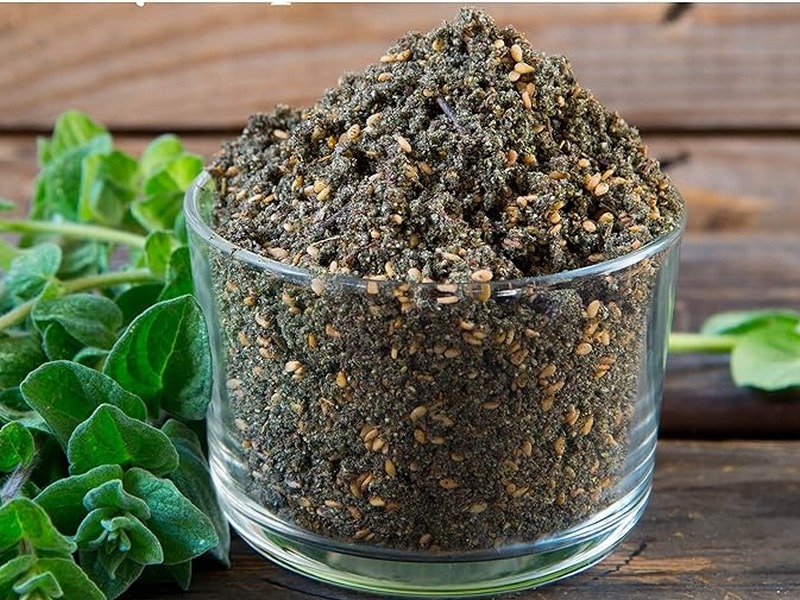Za’atar: Discover The Middle Eastern Spice Blend Redolent With Sumac
Za’atar is a versatile and aromatic Middle Eastern spice blend that has been captivating taste buds for centuries. This flavorful condiment combines herbs, sesame seeds, and tangy sumac to create a unique and irresistible seasoning that can elevate a wide variety of dishes and whose combination of herbs contains anti-inflammatory properties.
This post includes affiliate links. Click here for my full disclosure policy.
What is Za’atar?
Za’atar is a mixture of dried herbs, sesame seeds, sumac, and salt. While recipes can vary across different regions, the most common ingredients include:
- Dried oregano
- Dried thyme
- Dried marjoram
- Toasted sesame seeds
- Ground sumac
- Salt

The result is a fragrant, slightly tangy, and nutty blend that adds depth and complexity to any dish it touches.
- Sprinkle over hummus or labneh for an instant flavor boost.
- Mix with olive oil to create a dip for bread or a marinade for meats.
- Use as a seasoning for roasted vegetables.
- Sprinkle on eggs or avocado toast for a Middle Eastern-inspired breakfast.
- Add to salad dressings for an extra layer of flavor.
- Use as a rub for grilled meats or fish.
- Sprinkle over pizza or flatbreads before baking.
This is another spice blend that can be used as a seasoning, a topping, or a dip and is one of the many ways to add more fiber and probiotics to your diet. Your tummy will thank you.

Traditional Dishes Using Za’atar
1. Manaqish (Za’atar Flatbread)

Manaqish, also known as manakeesh, is a popular Levantine flatbread topped with a mixture of za’atar and olive oil. It is often enjoyed for breakfast or as a snack and can be found in bakeries across the Middle East.
2. Labneh with Za’atar

Labneh, a strained yogurt cheese, is frequently sprinkled with za’atar and drizzled with olive oil. This combination is typically served with pita bread and is a staple in Middle Eastern mezze spreads.
3. Za’atar Roasted Chicken
Za’atar is used as a rub for roasted chicken, imparting a herby, tangy flavor to the meat. It is often paired with other Middle Eastern spices and ingredients like lemon and garlic to enhance the dish.
4. Fattoush Salad

Fattoush is a traditional Levantine salad made with mixed greens, tomatoes, cucumbers, and crispy pieces of pita bread. Za’atar is sometimes added to the dressing or sprinkled on top to add an extra layer of flavor.
5. Za’atar Potatoes
Roasted or fried potatoes seasoned with za’atar make for a delicious and aromatic side dish. The spice blend adds a unique twist to the classic potato dish, making it a favorite in many Middle Eastern households.
6. Za’atar Pide
A fusion of Turkish and Lebanese cuisine, za’atar pide is a type of Turkish flatbread topped with za’atar. This dish combines the fluffy texture of pide with the distinctive flavors of za’atar, creating a delightful snack or appetizer.
7. Za’atar Fish
Za’atar can be used to season fish, adding a tangy and herbaceous flavor. It is particularly popular with grilled or baked fish, often accompanied by a drizzle of olive oil and a squeeze of lemon juice.
8. Za’atar and Olive Oil Dip
A simple yet flavorful dip made by mixing za’atar with olive oil. This dip is commonly served with warm pita bread and is a staple in Middle Eastern dining.
9. Za’atar Eggs
Za’atar is a popular seasoning for eggs, whether they are scrambled, fried, or poached. The spice blend adds a burst of flavor, making it a perfect addition to breakfast dishes.
10. Za’atar Salad
A salad made with fresh or pickled za’atar, pomegranate molasses, finely chopped tomatoes, and sometimes olives. This dish is a popular meze in the Levant and offers a refreshing and tangy flavor.
These traditional dishes showcase the versatility of za’atar and its ability to enhance a wide range of foods with its distinctive flavor. Whether used as a seasoning, a rub, or a topping, za’atar brings a taste of the Middle East to any meal.
Health Benefits
Beyond its delicious taste, za’atar also offers potential health benefits:
- Rich in antioxidants from herbs and sumac
- May have anti-inflammatory properties
- Sesame seeds provide a good source of calcium and iron
- Herbs like thyme and oregano have been traditionally used for their digestive benefits.
Za’atar is more than just a spice blend; it’s a gateway to the vibrant flavors of Middle Eastern cuisine. Whether you’re looking to add depth to your everyday cooking or explore new culinary horizons, za’atar is a must-have condiment that will transform your meals with its unique and enticing flavor profile. Give it a try, and you’ll soon find yourself reaching for this versatile spice blend time and time again.
Reap the Benefits of Za’atar
- A plant-based healthy food that generates health-promoting effects, especially on chronic and cardio-metabolic diseases.
- Za’atar mixture is commonly employed in the Mediterranean diet and is rich in bioactive compounds.
- Za’atar components modulate gut microbiota, oxidative stress, chronic inflammation, and obesity.
- The combined action of Za’atar components may generate beneficial effects for human health.

Here is a link to a favorite blend of za’atar ~ enjoy!
Za’atar
Ingredients
- ½ cup sesame seeds
- ¼ cup dried oregano
- ¼ cup dried thyme
- 2 tblsp dried marjoram
- ¼ cup ground sumac
- 1 teas salt
Instructions
- Begin by toasting sesame seeds in a dry pan until lightly golden and fragrant. Set aside to cool.
- In a bowl, mix all of the spices.
- Add the toasted sesame seeds to the herb mixture and stir well.
- Store tightly covered in a dark place.


